#DA lore
Explore tagged Tumblr posts
Text
Reminder that there is an elven servant in the Val Royeaux courtyard who stumbled upon the temple of Mythal in his youth, supposedly directs the Venatori there, and begins having dreams of a woman whispering to him in the night and calling herself Mythal. He later gains Mythal’s vallaslin if you return to the courtyard! I transcribed the audio below - I did my best to get them in the right order! It’s been a while so the line placement may not be 100% correct. A friend was interested in this, and I decided to share this here too in case it is of interest to anyone else.
Noble: Those men who came to speak to you at the manor. Who were they?
Servant: My brother and several of his friends. They asked about Ambassador Briala.
Noble: They didn’t think she was staying with me, surely.
Servant: No Sire, they asked when I last saw her. We were once friends, remember?
Noble: I’d forgotten that you knew Briala.
Servant: When I lived in the palace, prior to working for you. We’ve barely spoken since.
Noble: Oh, I wasn’t accusing you of anything. I know how elven servants can be.
—
Noble: How odd that more men show up at the manor to speak with you, you and not I.
Servant: I apologise sire. I had never met those men before.
Noble: And what did they need? Nothing unsavoury I hope.
Servant: I would never do anything to jeopardise your reputation, Sire.
Servant: They asked about ruins, something I found when I was a child. Rather strange they knew about it at all.
—
Noble: How is it you know anything about ruins?
Servant: You forget sire, before I became a servant at the palace, I was with one of the Dalish clans.
Noble: Ah, yes. I keep forgetting because you don’t have those ridiculous markings on your face.
Servant: I was too young. Long ago as it was, I remember the Arbor Wilds as if it were yesterday.
—
Servant: Sire. You should know those men approached me again.
Noble: Again? The last time they came to the manor, I told them to leave you be!
Servant: They came to me in the market. They claim I misdirected them, but I swear I didn’t.
Noble: No need to worry. I am your patron, not them. I won’t bow to Tevinter scum, that’s for certain.
—
Noble: You are worrying Madame with your shouting during the night. Not to mention the other servants.
Servant: I can’t help it, Sire. A woman comes to me in my dreams, and she whispers things.
Noble: You mustn’t say that. Not in public. People will think you’ll be taken by a demon.
Servant: She’s not a demon, Sire. She says her name is Mythal. But… I will be quiet. I promise.
#dragon age#lore#theory#dragonageobsessed#dragonage#da lore#dragon age lore#dragon age inquisition#dai
424 notes
·
View notes
Text
All About The Antivan Crows
(NOTE: This piece is a revised, 2nd edition of an old one, updated with information that has since been added to the lore. I will be deleting the outdated post to avoid confusion!)
The Antivan Crows, also known as the House of Crows, is a league of assassins from the northeast nation of, as their name suggests, Antiva. While their notoriety is especially high in their home country, the Crows are well-known across Thedas as brutally efficient killers. The bulk of their work is in Antiva, but they accept contracts all over the continent. Because of their reputation for adhering to agreements—something that should one fail to do makes one’s life forfeit as far as the Crows are concerned—they are an expensive but valuable investment.
To find the Crows anywhere from Ferelden to Seheron is not an unlikely sight. Nations at war send them to cut down leaders on opposing sides. Noble houses with grudges against each other send them to cut down family trees. And of course, politicians vying for power send them to cut down their competition. Whatever the reason, the Crows are never short on contracts. They are even willing to intervene in Circle politics.
While assassinations are the most common contract, and what the Crows are most known for, they’re also no strangers to thievery and spying. In Antiva City rests a giant, well-protected archive, housing of all their collected blackmail secrets, records of past contracts, recipes for their own special poisons, and other such valuables. The secrets in this archive are what keeps the Crows ruling Antiva from the shadows by controlling the nobility and merchant princes. That is, those that aren’t among their ranks.
At the very top of the power ladder is a council of Guildmasters made up of the eight most wealthy and powerful Crow Houses. The role of Guildmaster is most typically inherited down through a family, after successfully proving their skill by single-handedly killing a target with nothing but a ceremonial dagger. The Houses that are part of this council are known as Talons, ranked from one to eight, one being the most powerful. Talon has also been used interchangeably with Guildmaster when referring to the leader of one of these eight Houses.
Below the Talons are the lesser Houses, known as the Cuchillos. The Cuchillo leaders not Guildmasters but simply Masters, entitled as Lords, until their House may gain the rank of Talon. The ranks of these different houses can change with circumstance, gaining or losing power. House heads are also capable of taking over different houses by eliminating others, should they dare to be so ambitious. As such, despite being part of a larger organization, the Antivan Crows are always in competition with each other, and are not unknown to assassinate within their own ranks to get what they want.
The current Eight Talons are as followed:
Dellamorte
Balazar
Valisti
Kortez
De Riva
Nero
Cantori
Arainai
Other known Houses are:
Ferragani
D’Evaliste
Di Bastion
Members of the Antivan royal family and merchant prince dynasties routinely join the high-ranks of the Crows, either as a way to boost their social standing, or because they were forced into it. Assassinations are seen as part of everyday politics in Antiva, and how positions of power often change hands. Having strong ties with the Crows brings a noble family both leverage and security. They also have an arrangement referred to as The Azul Contract, in which bastard royal children are given a choice of either exile or joining the Crows – such as the case was with Viago de Riva. In return, the Antivan Crows all but run the nation. Even kings have come directly from the Crows.
While the Crows are mostly led by nobility, the bulk of their organization is made up of their recruits, though the word recruit makes it sound like there was a choice involved. The vast majority of recruits, referred to as compradi, are children between the ages of five and ten, bought as slaves or found on the streets alone. For example, Zevran Arainai was seven years old when he was bought by the Crows. Compradi are usually gathered in scores at a time, though only a few survive to become full-fledged assassins. The Crows keep the children in poor, cramped quarters, and raise them in emotionally detached and torturous conditions, teaching them to know nothing else but murder, as Zevran puts it. They are allowed no personal items, and are encouraged not to make friends. Along with general training and education in Crow ciphers and Crow history, training of recruits includes pitting them against each other, tests of pain resistance and gauntlets, and challenges like locking them in an oubliette for weeks. All this leads most Antivan Crows immune to morality as much as they are to interrogation. It also breeds loyalty to the only life recruits know. Indeed, many Crows would sooner kill themselves than betray the guild.
It is very rare for a recruit to rise all the way to the top of the organization’s tiered leadership, but not unheard of. For example, Teia Cantori, climbed her way to the head of her house – but despite this, she is still regarded as an “overreaching street rat” by her noble peers.
The Crows favour recruiting elves, as they are widely regarded as beautiful and unthreatening; both advantageous impressions for an assassin. However, they take recruits from all races. Assassins are most typically rogues, but the Crows also train warriors and even mages, providing protection for their apostate assassins from the Chantry.
An experienced Assassin may gain the title of Master Assassin with time, putting them just below the leader of their House in terms of rank. Masters are capable of deciding their own contracts, and command groups of Assassins below them. Guildmasters decide which Master Assassins get which contracts based on the amount of the contract’s offer they bid to give to the guild, and their chances of success. Regularly, Assassins are not allowed to bid on contracts, and are instead assigned contracts or roles in larger ones by the Master Assassins that command them. The exception to this is when an Assassin is attempting to gain the rank of Master.
Save for rare exceptions of escape, Crows are Crows for life. The only way to leave them is to make them think you are dead, or find someone willing to protect you from them. Otherwise they will hunt you down and kill you for betraying the guild, and that is the better alternative: Anyone who angers the Crows and lives risks ending up in their own personal prison, the Velabanchel, to spend the rest of their days locked up and tortured.
Antivan Crows are often easily identifiable by those who recognize their unique tattoos – a tradition taken from the Rivaini. Some of these designs are sacred to the Crows, marking them as which house they belong to, while others are purely decorative. While some Crows display their tattoos with pride and intimidation, others prefer to keep them hidden.
-----
SOURCES
Dragon Age: Origins
Dragon Age II
Dragon Age: Inquisition
Codex Entry: Zevran Arainai (Dragon Age II)
Codex entry: Blackfeather Boots (Dragon Age II)
Codex entry: Finesse (Dragon Age II)
Codex Entry: The Crows and Queen Madrigal (Dragon Age: Inquisition)
Item Description: Gift of the Talons (Dragon Age: Inquisition)
Dragon Age: Tevinter Nights
Dragon Age: Last Flight
Dragon Age: The Silent Grove
Dragon Age: Deception
Dragon Age: The World of Thedas vol. 1
Dragon Age: The World of Thedas vol. 2
Dragon Age Promotional Wiki: Assassin
-----
If you find these kinds of pieces fun and/or helpful, please consider supporting me!
429 notes
·
View notes
Note
So what spirits do you think the Evanuris were? Like Elgar'nan would be Command, Mythal -> benevolence, Solas is wisdom -> pride, but what do you think the rest were?
I like to think June is Inspiration (made the eluvians), Sylaise would be Harmony, Dirthamen/Falon'din are the shattered remnants of Wisdom (<- i get this from this quote on Dumat: "in silence is the beating heart of wisdom). Dirthamen would be Knowledge -> secrecy/deceit(?) and Falon'din would be Learning corrupted into Hunger?
Sorry for the rambling- but I love this blog and Evanuris being former spirits just fascinates me!
Well met, wanderer of the Fade!
I have thought about this a lot, honestly, and I’m still coming to my final conclusions on the nature of the Evanuris. However, here are my current thoughts until I reach that section to dive deeper:
June – Innovation (The creation of the eluvians speaks to a mind driven by invention and transformative creativity.) When corrupted, it becomes Obsession.
Sylaise – Harmony (Her association with peace, fire, and the nurturing aspects of elven society suggest a spirit tied to balance and cohesion.) When corrupted it becomes Stagnation.
Ghilan'nain – Creation (Her association with shaping creatures, monsters and guiding them ties closely to the act of bringing something new into being.) When corrupted it becomes Hubris*.
In this context, I wouldn't use hubris and pride to be the same. Think of pride as believing you're the best in the room, while hubris is believing you're above the rules of the universe.
Andruil – Competition (Her obsession with the Hunt and her repeated challenges to other gods suggest a drive defined by rivalry and dominance.) When corrupted, it becomes Madness.
As for Falon'Din and Dirthamen, I’m still untangling their threads, but I’m leaning toward them being shattered fragments of Discovery.
Dirthamen might represent Knowledge, with a drive that, when twisted, becomes Secrecy—hoarding knowledge for himself rather than sharing it.
Falon'Din could align with Learning, corrupted into Hunger—an insatiable need to consume, understand, and claim everything in his reach, even the souls of the dead. Which also aligns with comments made by Solas in DAI about Falon'Din's desire for worship.
I love your interpretation of them as remnants of Wisdom, particularly with the connection to Dumat’s quote: "In silence is the beating heart of wisdom." It aligns beautifully with their themes.
It’s such a fascinating idea to explore the Evanuris as once being spirits themselves—shaped, changed, and eventually corrupted by their own desires and the weight of their power.
Thank you for sharing your thoughts! Discussions like these are what make exploring this lore so rewarding.
May your path through the Fade remain well-lit!
—The Fade Codex
#da#da spirits#da2#dai#dao#datv#dragon age#dragon age 2#dragon age inquisition#dragon age the veilguard#datv spoilers#dragon age veilguard#veilguard#evanuris#mythal#elgar'nan#ghilan'nain#solas#falon'din#dirthamen#andruil#sylaise#thefadecodex answers#dragon age lore#da lore#dragon age meta#spirit complexity#evanuris origin
169 notes
·
View notes
Text

Emmrich would absolutely ugly happy-cry the first time he holds his child. Forget dignity. Put that tiny rolypoly little thing anywhere near him and he's going to cry enough to end a drought half a continent away.
He will not be managing a coherent sentence for the next half hour.
Tag for @lavenderprose cuz I know you've got baby fever real bad. Suffer with me.
DA lore/story details for this particular baby under the cut:
Normally by DA lore, a baby born to a human and elf parent would be considered elf-blooded, and is visually identical to a human-- elven magic enables them to interbreed at all by suppressing the elven genome. This baby is an anomaly! Her mom is elven but not a mage. So in an extremely rare turn of events, it's Emmrich's magic that enabled them to conceive. I'm considering her "human-blooded", in that it's the human side that got suppressed in order to make her a viable embryo. She ends up being Emmrich's only biological child-- the odds of a successful human-blooded kid are exceptionally low, his wife has multiple miscarriages-- but they do adopt foundling children, so this baby doesn't end up being an only child. Both her parents were orphaned so the adoptions are really important to them both emotionally 🥺 this lil cutie was his first, though.
87 notes
·
View notes
Text
Now that I've finished dao and da2, I'm finally starting to realise why certain things in datv are just...approached so seriously, which to a first time player was a bit confusing but ultimately not something to worry about. And now, actually knowing why it's horrifying for Lucanis and Spite to be bound & by blood magic, at that, and why the Blights are simultaneously normal and also a horrible thing to live with (see: Grey Wardens. Griffons. Why Antoine and Evka would risk the secret of the Joining to save a village of dying blight victims), all the Elven history stuff (which was genuinely mortifying in reverse because I Know The Truth, now, from datv) and like...even why it's so controversial for qunari/tal-vashoth to live in Rivain, like Taash, I'm definitely sure that my perspective is going to shift dramatically when I replay datv after getting through Inquisition.
23 notes
·
View notes
Text

(excerpt from Metaphysics of Thedas part 2)
The foreshadowing they've done by putting Mythal's "Nike" statue in the Raw Fade in DAI
I am gnawing at the bars of my enclosure
#datv#da the veilguard#dragon age the veilguard#dai#da inquisition#dragon age inquisition#da lore#dragon age lore#foreshadowing#mythal#the blight#da meta#in that piece I claimed it was just about Mythal's fight with Andruil#WELP
20 notes
·
View notes
Text




Crossroads eavesdropping 1/?
I've been very fascinated by these little conversations that you randomly get in the crossroads and have decided to collect them all.
This in particular seems very interesting because its relevant to the origin and history of the Lighthouse, and I am shamelessly OBSESSED with that place. I absolutely adore it and want to know as much as possible about it.
Dragon Age: Veilguard was the first Dragon Age game I played and I intentionally went into it avoiding most setting and world lore, mainly for immersion and enjoyment reasons. I really wanted to be surprised this time around, especially because I tend to be the type who has no self control when it comes to spoilers.
I already knew plenty about Solas because I had been a fan from afar for quite a while, and as a DnD lover, I also knew that DA draws a lot of inspiration from there, so that was enough and I tried avoiding anything more.
Now, of course I have read more and know more. That being said, I cannot find much info on the creation of the Lighthouse.
Who "magiced" it into existence? When?
For the longest time I though Solas was its builder, but this conversation hints at the fact that it is actually older and I did actually find info that Solas more or less snatched it from the Evanuris. In the above conversation Elgar'nan wants it back apparently, and Ghilan'nain wants to reclaim it, so that solidifies it not being created by Solas.
And isn't it interesting how he specifically mentions all traces of Fen'harel being "erased from its walls"? Does Elgar'nan know Solas painted the Lighthouse walls with his regrets and memories?
The conversation is so so circular. Vhen'theneras should mean "people of the waking dream". Was this the original name of the Lighthouse? Was this another "wonder" they lost? He says Solas "raised" it in mockery of his Tower of Learning. Raised what? Is he talking about a different building?
Or, was the central beacon created by Solas, while the rest of the complex of buildings floating around were part of the original layout of the place. I can definitely see Solas creating that huge phallic symbol obelisk in the centre, to tower over whatever else Elgar'nan had his mark on. When taking over the Lighthouse, Solas practically tore the whole thing apart, snatched it and moved it away, hence why most of it is floating around in ether.
In any case, the boys are fighting over castles and egos again. One of the best parts of this entire elven saga honestly. lol
The entire video of the conversation below. Really helpful if you want to hear the tone of it, but also see my Idunn fidgeting for no reason, as is proper for a pixel avatar of someone with adhd (me).
#dragon age the veilguard#dragon age#da: the veilguard#solas#rook#veilguard lighthouse#lighthouse#veilguard meta#veilguard theories#da lore#dragon age lore#dragon age meta#ghilan'nain#elgar'nan#oc: idunn aldwir
34 notes
·
View notes
Text
All Lore from the Dragon Age: Official Cookbook: Taste of Thedas
This is going to be a long post with all the lore from the cookbook collected in one post. This is only going to be counting the lore in the "blurbs" so to speak as the actual recipes themselves, which are not meant to be set in-world.
Additionally, it should be noted that I am unable to say one way or the other if the props used in the photos or the etching art shown on some recipes are to be taken as reflecting the canon the cookbook narrator is in. For the sake of completeness, I have included the less conclusive elements.
Shoving everything below the cut for length as well as to help people avoid spoilers. Think I got everything... There is a lot in this book honestly.
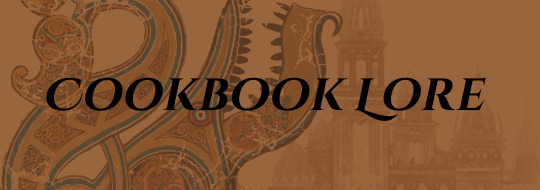
Cookbook Lore
World State
Cassandra is Divine.
The Hero of Ferelden is a Cousland Warden.
The Warden gave Leliana Schmooples.
Hawke is a non-mage, as Varric knows Bethany.
Hawke is diplomatic in personality.
Bull's Chargers, Krem, and Bull are all alive.
Cullen stayed off lyrium.
Celene is empress; Briala and Gaspard are still alive.
Alistair is king.
Varric is viscount.
Uncertain aspects of the world state:
The suggested lore based on the art, props used in photos, and vague wording in blurbs. These are not for certain this is the canon.
Briala is described as a spymaster and lover, implying she was possibly reunited with Celene.
Celene, Briala, and Gaspard are possibly working together in the truce. But the wording is vague it could simply be Celene ruling alone while Briala and Gaspard live.
Cole was encouraged to be more human and is traveling with Maryden Halewell.
Cullen got his mabari.
Josephine was romanced by the Inquisitor.
Morrigan has Keiran.
The Hero of Ferelden romanced King Alistair.
Food Lore
Lentils and onions are common ingredients to find in pantries across Thedas.
Ferelden has reliable access to tomatoes that allows them to use them regularly in their food.
Fereldans are known for their love of soups, stews, pickled eggs, and turnips that it is regularly joked about and seen as a stereotype. Devon regularly comments on the known expectations.
Turnip and Mutton Pie is a classic Fereldan dish served in taverns across the nation.
Nevarra food culture holds that food is suppose to be a feast for the eyes and mouth. Leading to their plating to be dazzling and seen as works of art.
The Jade Ham, is a smoked Anderfels ham with a particular glaze made from wildflowers and turns the ham as hard as jade.
The Anderfels are hostile and often considered inhospitible in certain areas. But despite the harsh environment, pigs farm well there and as a result are much larger than elsewhere in Thedas.
There are custard connoisseurs across Thedas.
Lichen ale is toxic, though most dwarves are able to handle it. However, non-dwarves can only tolerate a few sips of the drink.
Isabela has a drinking game based on how many enemies you have, it has killed at least one person.
The Rivaini tea blend is said to have healing properties such as helping alleviate headaches.
Dwarves underground raise giant spiders like people on the surface raise cattle and goats.
Orzammar has a contest where one is crowned as Orzammar's Best Sauce, the competition is so fierce people get underhanded in their attempts to acquire recipes. This has led to eateries, and in general people of Orzammar, to guard their recipes from others.
Orzammar also farms various mushrooms for eating.
Rice is commonly found in Antiva and Rivain, however it is not a large export for Antiva so it is a rare grain for folks in Ferelden. Due to it not being exported, rice is a cheap food item in Antiva and is very common in the more mundane foods of commoners.
Wyvern, like phoenix, can become deadly poisonous if eaten when they aren't prepared properly.
A jam maker lives in Orzammar, importing individual ingredients so they can make the jam themselves and hopefully sell it cheaper than imported jam.
Fauna
Mentioned through out the cookbook, not necessarily as ingredients themselves but sources for other food items.
Ayesleigh gulabi goat - Rivain
Cattle
Cave Beetles - Underground
Chicken
Crab
Cuttlefish
Dracolisk
Giant
Giant Spider
Goat
Gurgut
Halla
Lamprey
Lurker
Mackerel
Mussel
Nug
Pig
Prawn
Quillback
Sheep
Shrimp
Snail
Turkey
Wyvern
Additional Lore
The golden nug statues do exist in Thedas, Devon mentions seeing one in Haven and hearing rumors of there being more.
Fereldans who worked for the Inquisition would leave Commander Cullen pickled eggs on his desk while he was going through the worst of his lyrium withdrawal symptoms.
Spring time is gurgut mating season, and travelers are advised to keep their distance.
Starkhaven is oval in shape, shaped by rings of tall, grey stone walls, is filled with lavish estates, fountains, and sits on the Minanter River.
Makes reference to the ambient events of where Cole dumped a bushel of turnips onto a fire.
Food: Dishes, Ingredients, and More
Foods/Dishes
These are mentioned, referenced, and/or introduced in the cookbook description of the food, these aren't including the ingredients or foods mentioned in the recipes.
If the item is marked with **, it means there are multiple cultures with the same dish but the cookbook is offering specifically that as the reference point.
Apple Grenade - Antiva
Bark Bread - suggested alternative to black lichen
Biscuit
Biscuit, sweets
Black Lichen Bread - Orzammar
Blancmange - a white pudding dish from Orlais
Blood Orange Salad - Nevarra
Boiled Turnip
Bun
Bun, sweet - a pastry served as dessert
Cabbage Soup - Ferelden
Cacio e Pepe
Cherry Sauce
Cherry Cupcakes - Tevinter
Chocolate Cake
Chocolate Cream
Cinnamon Rolls
Couscous Salad - Rivain
Crab Cakes - Kirkwall
Croissant - Orlais
Crow Feed - Antiva
Custard
Dark Bread
Eggs à la Val Foret - Orlais
Fish Chowder - Antiva
Fish Wraps/Fish Pockets - Seheron
Flat Bread - Nevarra
Fluffy Mackerel Pudding - Ferelden
Forest Fruit Cobbler - Dalish
Found Cake - Ferelden
Fried Crab Legs - a substitute version of fried young giant spiders
Fried Young Giant Spiders - Orzammar
Gnocchi - Antiva
Goat Custard - Rivain **
Grilled Poussin - Chasind
Gurgut Roast with Lowlander Spices and Mushroom Sauce - Avvar
Hearth Cakes - Dalish
Hearty Scones - Ferelden
Honey Carrots - Orlais **
Jade Ham - More suited for a weapon, stated to not be suited for eating.
Lamprey Cake - not made of real lamprey, just a cake modeled after it.
Lentil Soup - City Elf **
Llomerryn Red - Rivain
Mashed Turnip
Merrill's Blood Soup - Dalish
Mushroom Sauce
Nettle Soup - origins unclear
Nug Bacon and Egg Pie - Ferelden
Paella - Antiva
Pastry Pockets - recipe originates with the Grey Wardens, cookbook provides the Orlesian Grey Warden variation **
Peasant Bread - Orlais
Pickled Eggs - Ferelden
Pickled Lamprey - Free Marches
Poached Egg
Poison Stings - Chocolate-coated orange peels from Tevinter
Potato and Leek Soup - Ferelden
Pumpkin Bread - Tevinter
Red Grape Compote
Rice Pudding - Tevinter
Roasted Fig
Roasted Cave Beetles - Orzammar
Roasted Prawns - a substitute prawns for cave beetles
Roasted Turnip
Roll, pastry
Snail and Watercress Salad - Avvar
Sour Cherries in Cream - Orlais
Spiced Jerky - Dalish
Steamed Turnip
Stir-fried Turnip
Strawberry and Rhubarb Cobbler - Ferelden
Stuffed Cabbage - Ferelden
Stuffed Deep Mushrooms - Orzammar
Stuffed Vine Leaves - Tevinter
Sweet and Sour Cabbage Soup - Ferelden
Toasted Almonds
Traviso Energy Balls - Antiva
Tzatziki - Tevinter
Turnip and Mutton Pie - Ferelden
Unidentified Meat - a common tavern food in Tevinter
Yogurt Dip - Nevarra
Drinks
Chasind Sack Mead
Chasind Wildwine
The Emerald Valley
The Golden Nug
The Hissing Drake
Hot Chocolate
Lichen Ale
Pomegranate Juice
Rivaini Tea Blend
West Hill Brandy
White Seleney wine
Ingredients
These are only listed in the lore entries and not the actual recipes themselves as whether or not they are canon is questionable as the recipes recommend store bought items as well as ingredients that have unique Thedosian counterpart names.
Almond
Antivan Pasta
Apple
Apricot
Bacon
Bacon, Nug
Bark
Barley
Beef
Beetroot
Bell Pepper, red
Bitter Greens - this is a class of salad greens known for their bitter flavor.
Black Lichen - Underground
Blood Orange - Nevarra
Butter
Butter, Halla
Cabbage
Cave Beetles
Celery
Cinammon
Cheese
Cherry
Cherry, black
Cherry, sweet
Chicken
Chickpea - Rivain
Chocolate
Cocoa Powder
Corn, yellow
Corn, checkered
Couscous - Rivain
Crab
Cranberry
Currant
Deep Mushroom, various varieties
Dracolisk - The narrator suggests it being a potential meat in a recipe in Tevinter.
Dried Fruit
Eggs
Fig
Flour, semolina - Rivain
Giant - Suggested that Tevinter might serve giant
Giant Spiders - Underground
Goat
Grape, red
Grape Leaves/Vine Leaves
Grease
Guimauves - Orlesian
Gurgut - Avvar
Heavy Cream
Honey
Jasmine
Mackerel
Mango
Mint
Mussel
Mutton
Lamb
Lamprey
Leek
Lemon
Lemon Juice
Lemon Verbena
Lentil
Lichen
Licorice Root
Lurker - Avvar
Oat
Oil
Onion
Oregano
Pastry Dough
Peanut
Peanut Butter
Peppers, Hot
Peppermint
Plum
Pork
Potato
Prawn - said to have the same texture and flavor as cave beetles.
Puff Pastry - Orlais
Pumpkin
Quillback
Raisin
Raspberry
Rhubarb
Rice - Antiva and Rivain
Salt
Semolina Flour - Rivain
Shrimp
Snail - Avvar
Spinach
Strawberry
Sugar
Tomato
Turkey
Turnip
Watercress - Avvar
Wheat
Whipped Cream
White Chocolate
Wildflowers
Wyvern - Avvar, Orlais
Charts and Stats
Because I love a good visual rep of data, I collected some stats of the types of food, how many recipes are from where, and the amount of time a character was mentioned.
Types of Food
I did percentages for the course of food as well as the portion of options that are vegetarian, vegan, dairy-free, meat based, and alcoholic.
Food Types Stats

These charts show the ingredient percentage in the actual recipes and not the lore blurbs themselves. This is out of 72 recipes with the amount they were used in (-) after their percentage.
Left Hand Chart
Alcohol: 14.6% (27)
Dairy-free: 15.7% (29)
Egg-free: 25.4% (47)
Meat based: 16.2% (30)
Nuts: 3.1% (6)
Shellfish: 2.6% (5)
Vegan: 4.2% (8)
Vegetarian: 20.4% (39)
Top Right Chart
Alcohol: 37.5% (27)
Alcohol-free: 62.5% (45)
Bottom Right Chart
Beef: 11.4% (4)
Chicken: 17.1% (6)
Fish: 17.1% (6)
Lamb: 5.7% (2)
Pork: 28.6% (10)
Shellfish: 14.3% (5)
Turkey: 5.7% (2)
Percentage of Recipe Origins

Anderfels: 1.4%
Antiva: 11%
Avvar: 6.8%
Chasind: 2.7%
City Elves: 2.7%
Dalish: 6.8%
Ferelden: 15.1%
Free Marches: 5.5% Kirkwall: 2.7% Starkhaven: 2.7%
Grey Wardens: 1.4%
Nevarra: 2.7%
Orlais: 13.7%
Orzammar: 9.6%
Rivain: 4.1%
Seheron: 1.4%
Tevinter: 9.6%
Character Mentions
I organized the chart by game and the characters in alphabetical order.

DAO Alistair: 2 Dog: 2 Hero of Ferelden (Cousland): 6 Leliana: 1 Loghain: 1 Morrigan: 1 Sten: 1 Zevran Arainai: 2
DA2 Anders: 2 Bethany: 1 Fenris: 3 Hawke: 1 Isabela: 1 Merrill: 2 Sebastian Vael: 1 Varric: 3
DAI Briala: 1 Bull's Chargers: 2 Cassandra: 2 Celene Valmont: 1 Cole: 2 Cullen: 3 Dorian: 2 Friends of Red Jenny: 1 Gaspard: 1 Josephine: 3 Krem: 2 Sera: 1 Solas: 4 The Iron Bull: 4 Vivienne: 2
Food Courses

I thought it would be interesting to see how the recipe groups totaled out in how much of the book they made.
Drinks: 12.5%
Baked Goods: 13.9%
Sweets: 11.1%
Sides: 5.6%
Starters and Refreshments: 12.5%
Travel Food: 13.9%
Soup and Stew: 11.1%
Main Course: 19.4%
Wanna support this blog? You can check out my ko-fi.
#dragon age#dragon age official cookbook#dragon age taste of thedas#da: tot#da lore#long post#book stats#alcohol cw#lore#foods of thedas#dragon age food lore#cassandra#hero of ferelden#warden cousland#hawke#cullen#varric#alistair#alistair theirin#zevran#zevran arainai#devon the food nerd#This was so long but I think I got all the stuff from the cookbook. Please let me know if I missed anything
339 notes
·
View notes
Text
The Temple of Mythal and Greek Sculpture
Or: How Bioware takes from history without any nuance.
--
Picture this. You're me, playing Inquisition for the first time. You get to the Temple of Mythal, the doors shut behind you and you finally get to look around. It's a typical elven ruin for the game, nothing much seems different...
Hold on.
Hold the fuck on.
You know what that is.
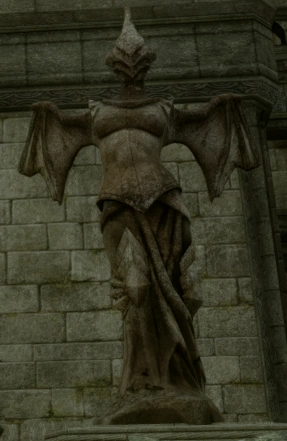
You know what that's based on, and for a long time after it tickles you. Oh, maybe that meant something in the grander scheme of things! We've never seen such a blatant reference to a real-life sculpture anywhere else in game (to my knowledge at the time)! Maybe it'll come up later and it'll all make sense!
Here's the deal. I've been bothered by this for years. The more I think about it, the more angry I become. Anger over a single fucking type of statue, you say? There's a lot of other shit to be angry over in this game, and you choose this?
YES! I CHOOSE THIS! AND THIS IS WHY.
--
Picture this. You're me again, aged 14 this time. You're in the Louvre, the first museum of Western classical art you've ever been to. You've grown up in a place where this interest could only be cultivated from extra-curricular reading, and for a kid that age from my country to be ass deep in Greek and Egyptian myth is frankly lmao. Neurodivergent. Anyway.
So we're wandering around the Louvre, I've just taken my parents through the Egyptian section and given them a thorough infodump on everything I know about burial rites.
And then we enter this room. And I very nearly fall to my knees when I catch sight of her.
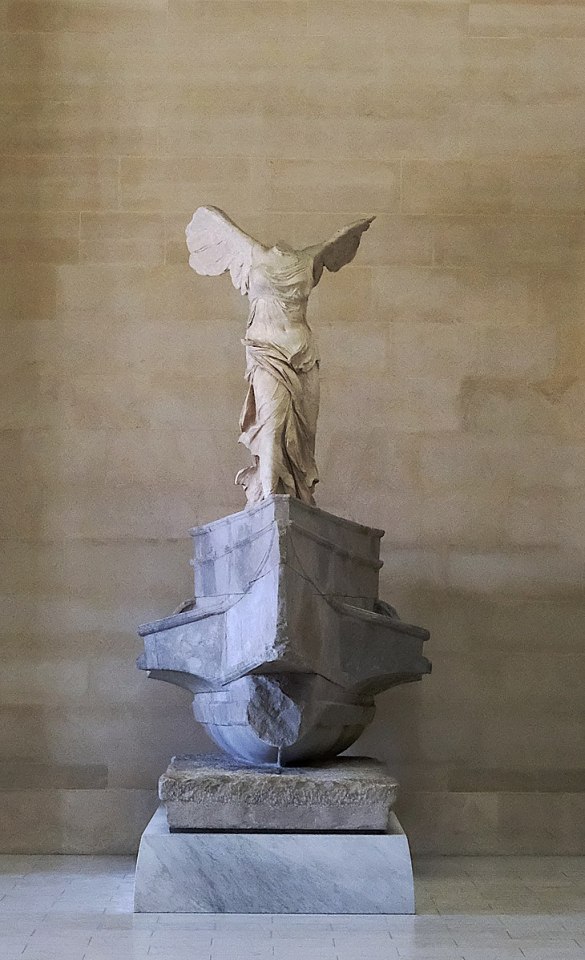
This is the sculpture the statues at the Temple of Mythal are based on - one Winged Victory of Samothrace.
She is a sculpture from the Hellenestic era, depicting the goddess Nike stood at the prow of a ship. Her head and both arms are missing, save one hand with two fingers (also in the Louvre but displayed separately). She was found on the Greek island of Samothrace, among the ruins of what was known as the Sanctuary of the Great Gods. It seemed like she was displayed at the top of a hill, looming down at all that regarded her.
I’ve had the absolute privilege of seeing her in person twice in my life, both before and after the 2013 restoration. And let me tell you, regardless of which staircase that leads you there, the sight of her will stop you in your tracks.
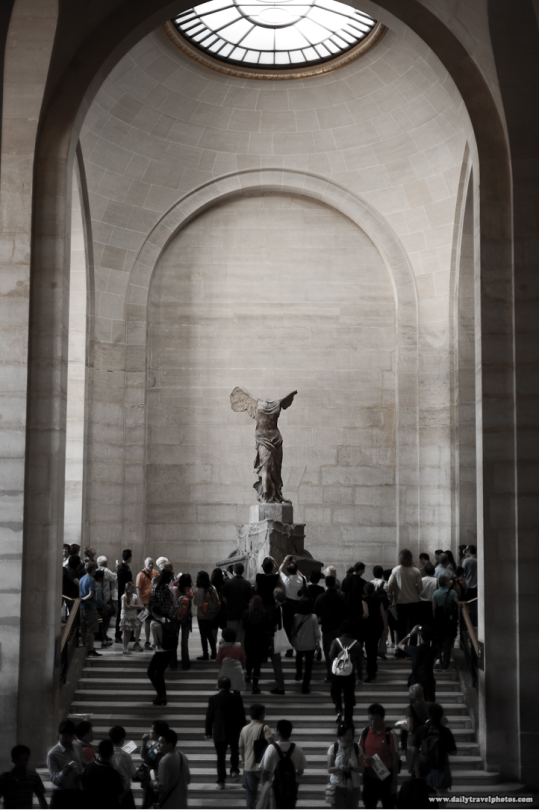
[Now with people, for scale.]
She is massive. Larger than life, and immediately is the centre of your attention. It's not the fact that she has no head, no arms. No, you will realise the closer you get to her, the more you're able to appreciate the details of this absolutely astounding piece of history.
No. It's because she feels so alive.
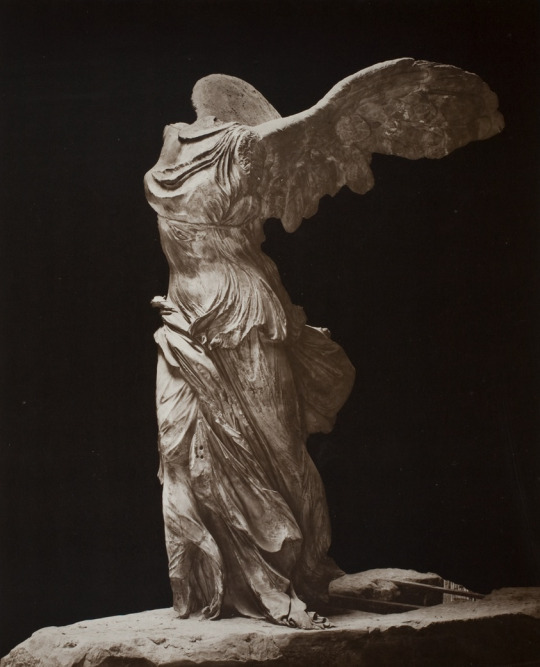
The way her robes drape against flesh, wet from sea-spray or rain, yet flowing with the motion of an invisible wind. The wings cast behind her dramatically as her right foot steps forward. Standing tall and proud, unflinching, unbowed against the elements. Even without her arms, you can feel how dynamic the torso and legs are.
You don't need to be an art historian, or even have any knowledge of Greek myth or art history to stand in front of her, as I once did as a young teen, and nearly be brought to tears.
So.
This brings me to the first of the two main gripes I have with the way this sculpture is used in Inquisition.
Compared to the way she's displayed in the Louvre, and also presumably how she was presented to her original audience - larger than life, looming, powerful, beautiful - she is relegated instead to smaller, repeating statues of the same nature throughout the temple.
This diminishes the purpose of the original sculpture, which was to instill a sense of awe and wonder. The singularity that forces you to focus and appreciate the scale and intricacy. The aura, the gravitas of having a single, massive sculpture of such a dynamic figure is completely gone.
And to make things worse, they Mythal-ify her. Adding a helmed head and changing her beautiful feathered wings to leathery dragon wings. They don't even add arms, which is odd because the original sculpture very clearly is missing its arms.
And, may I ask, Why?
It feels cheap, like they saw the Winged Victory and were like 'oh shit this is a cool sculpture, we should add it in game' without giving any fucking thought to what the sculpture means.
Which brings me to the second gripe. The complete disregard for the symbolism of the Winged Victory.
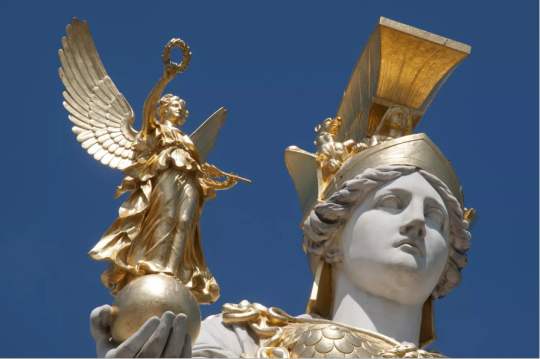
Detail from the Athena fountain, Parliament Building of Vienna, showing Nike the Winged Victory in the palm of Athena's hand [source]
Nike is a minor Greek deity, said to be the daughter of Pallas (a Titan) and the river Styx. Her other siblings by the same parents include Zelus (Zeal), Bia (Might) and Kratos (Strength).
Yes. That Kratos.
She was one of the earliest gods to pledge her allegiance to Zeus in the Titonomachy, and after the victory of the Olympians, Nike and the other gods that allied with them were allowed to live on Olympus. In her aspect as Victory, she is closely associated with several of the major Greek gods, and in particular, Athena.
There's also her Roman counterpart, Victoria. This version doesn't come with the backstory Nike has, but is more of a general concept of victory. This is the aspect that is present in a lot of the modern sculptures and interpretations of Nike/Victoria:
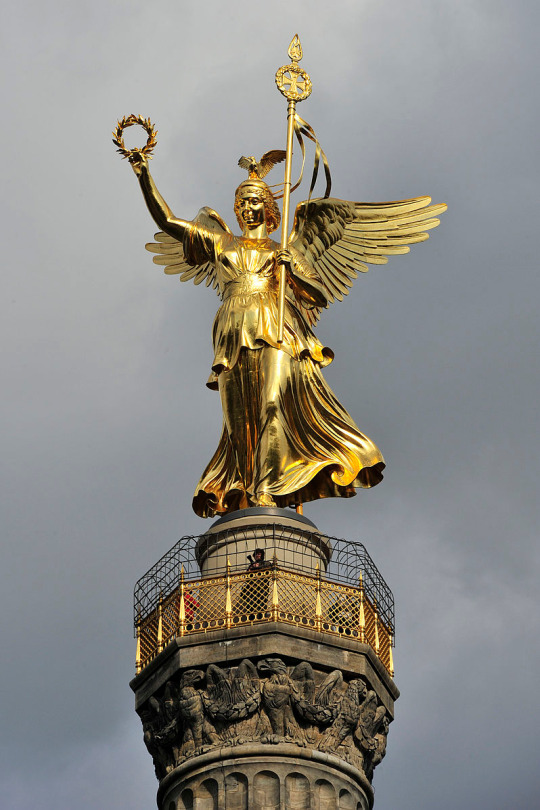
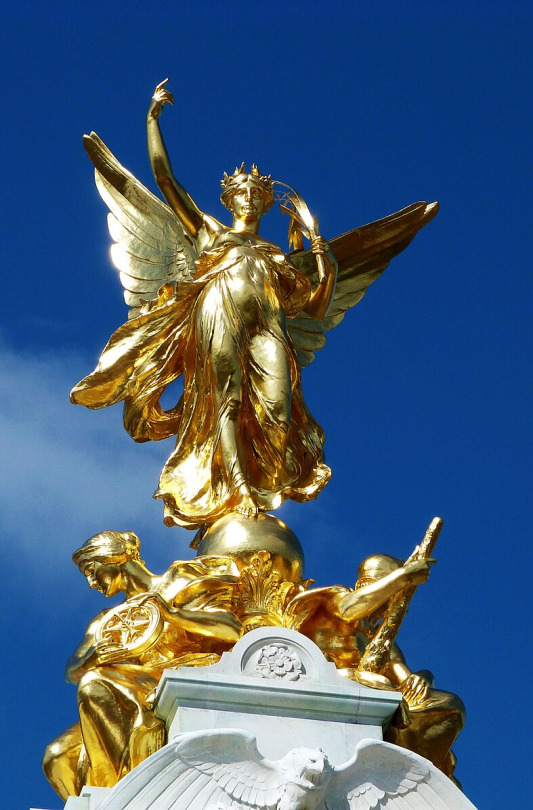
Left: Detail from the Berlin Victory Column. Right: Detail from the Victoria Memorial, London. Note the similar iconography, of a woman seemingly standing against a strong wind, fabric and cloth adhering and yet flowing against the breeze, wings outstretched.
From this, we can probably extrapolate what our beloved Winged Victory might've looked like. Here's an artist's render of one possibility:

There's some iconography we need to go through before moving on - symbols that are commonly associated with Nike/Victoria.
One is the trumpet as see in the reconstruction above, the sound and symbol of the end of war, of impending peace. Another is the laurel wreath, another Greek symbol of victory and achievement. Famously, laurel wreaths were used to crown victors of the original Olympic games.
This is another conversation entirely, but there’s a discussion to be had about the duality of Elgar’nan and Mythal, in term of vengeance and justice, and how an emotional rage versus a calculated wisdom can be compared to the difference between the two Greek gods of war – Ares and Athena.
If we can compare Mythal to Athena, in the sense of her wisdom in making difficult decisions, then it’s not a stretch to associate Mythal with the symbolism of Nike, and therefore explain the presence of statues similar to the Winged Victory in her temple.
But since Bioware absolutely did not put this in the game for anything other than the Aesthetic, there’s some problems that need to be addressed.
Mainly in the way in which these statues are scattered throughout the temple. If you wanted static, ominous statues to line the walls as your player characters explore, perhaps have like, I dunno. Less dynamic statues that you reference?
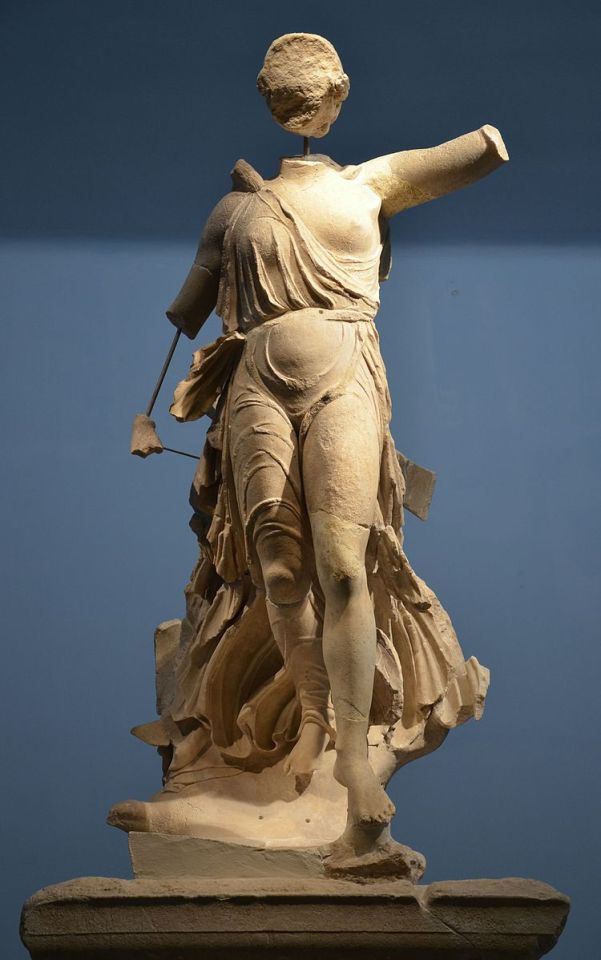
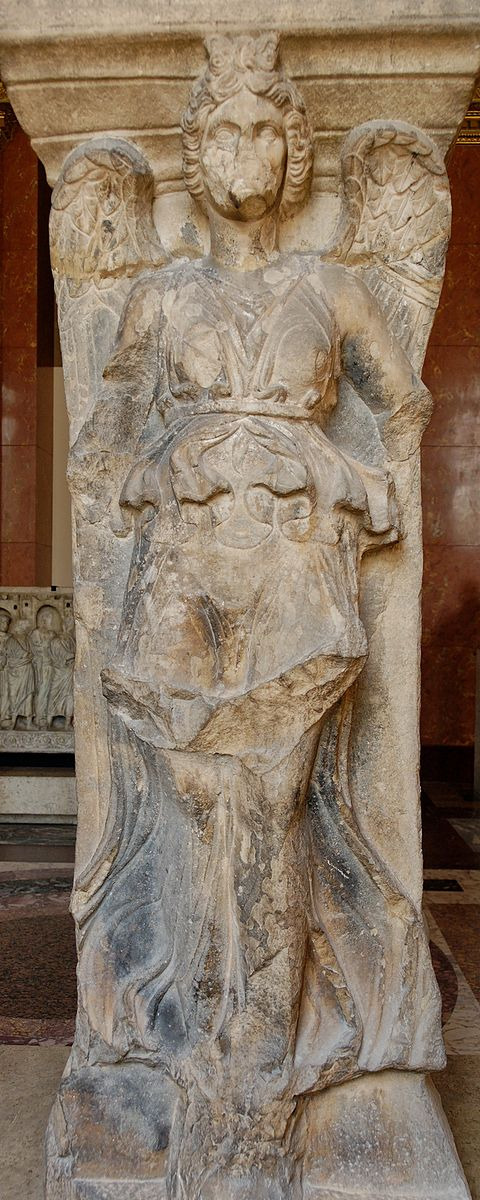
Left: Nike of Paionos, Right: Stele 1 of Las Incantadas
Or maybe instead of statues, have friezes lining the walls. Like this one from the equally iconic Pergamon altar, depicting the Giganomanchy.
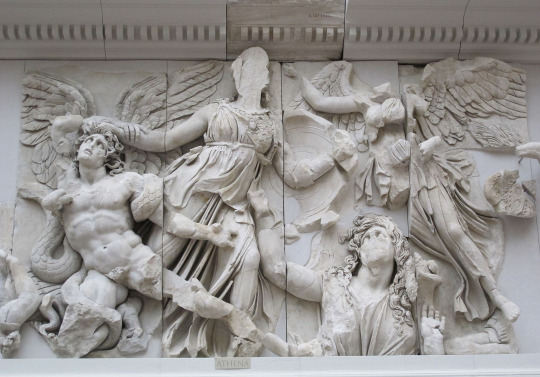
It’s the same symbolism, the wings, the smiting of foes and victory of good over evil.
And then perhaps, at the heart of the temple... where, y'know Bioware, lay a body of water sacred to Mythal herself, you could've perhaps done something remarkable. You could then have had the most dramatic and beautiful entrance you’d ever seen.
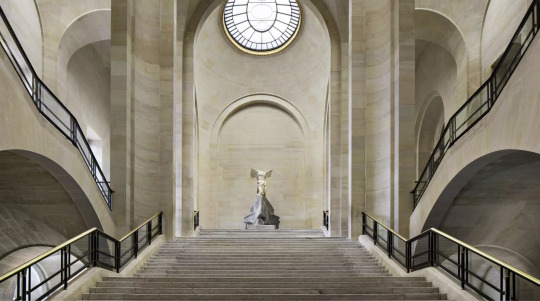
[Nike, at the iconic Daru Staircase, the Louvre]
It was at this moment that Mythal walked out of the sea of the earth's tears and onto the land. She placed her hand on Elgar'nan's brow, and at her touch he grew calm and knew that his anger had led him astray. - Codex entry: Mythal: The Great Protector
Mythal herself strides out of the Well Of Sorrows, the metaphorical tears of her followers that died and kept their knowledge alive in her name. Her (draconic) wings spread out, (restored) hands outstretched to touch her husband, to calm the rage that nearly destroyed this world.
A symbol of victory against the blind rage of a god against His father, the Sun. A symbol of wisdom and grace, against the violence of hatred. A divine sense of something bigger than anything we could imagine.
There's also the lack of iconography regarding victory, instead piling on some cheap representations of what we think of as Mythal. That's another post entirely on the symbolism of the Elven gods, but if Bioware really wanted to hone in on the Athena/Athena Nike parallels, they might have thrown in the trumpet/laurel/palm leaf symbolism with the statues, alongside the dragon wings.
If this were the case, then maybe, just maybe, Inquisition would’ve then earned the use of this sculpture in the game.
Sources not listed above/Further reading if you're interested
https://www.louvre.fr/en/explore/the-palace/a-stairway-to-victory
https://www.worldhistory.org/article/1412/winged-victory-the-nike-of-samothrace/https://smarthistory.org/nike-winged-victory-of-samothrace/
https://smarthistory.org/nike-winged-victory-of-samothrace/
https://www.khanacademy.org/humanities/ancient-art-civilizations/greek-art/hellenistic/a/nike-winged-victory-of-samothrace
#da lore#da meta#mythal#temple of mythal#dragon age#da lore and meta#yo this has been simmering and brewing in my brain for like 8 years now not kidding#and im already neck deep in like..... figuring out the evanuris and trying to tie them into real world mythology and thats super fun too!!!#watch as this consumes and destroys me#my writing
163 notes
·
View notes
Text
From the new ‘Making of Dragon Age: the Veilguard’ behind the scenes video: 👀
“As we’ve gone through DAO, DA2, Inquisition… magic has become more and more present, and part of that is because Solas has been slowly preparing this ritual for longer than anyone in the Dragon Age universe is really aware of.”
#dragon age#datv#lore#theory#dragonage#solas#da lore#dragon age 4#da4#dav#dragon age veilguard#dragon age the veilguard#datv spoilers#datv speculation#datv solas
286 notes
·
View notes
Text
Life in Rivain - What We Know Going Into Dragon Age: The Veilguard
For the first time in the game franchise, it has been confirmed that players will get the opportunity to explore Rivain. As such, we will finally be learning a lot more about Rivain upon its release. This piece is about the information we have thus far.

Location & Population
The Kingdom of Rivain, founded in -44 Ancient, is located on the northeastern peninsula of Thedas. Surrounded nearly entirely by water, its only land connection is Antiva.
Those native to Rivain are called Rivaini. Just like any nation in Thedas, there are different racial/ethnic backgrounds who live there – however, the majority of Rivain’s population is Black.
There is also a notable qunari population in Rivain, dating back to when they arrived in Thedas in 6:32 Steel. Kont-aar still exists as a large Qunari settlement in the northern part of the nation – it is regarded as peaceful.
The capital of Rivain is Dairsmuid, which sits on the Rialto Bay. Dairsmuid is the only place in Rivain that has any real Chantry control.
Relations
Because Rivain has a lot of flavour profiles found only in the northern part of Thedas, other nations highly value their food exports. As Rivain is friendly with the Qunari, they are willing to trade in Seheron, too.
Rivain has a “less-than-cordial” relationship with Tevinter. It also has an unserious rivalry with Antiva.
Culture
The Rivaini are traditionally a matriarchal society, believing that women are best suited to rule. Major decisions within a community rest on the head of elder women, who is often a Seer (see: Magic).
Rivain has a currency-based economy. However, there is, generally speaking, a greater value placed in making sure everyone has what they need over monetary gain. For example, if one community has a bad year the neighbouring communities will send supplies and labour to ensure its people do not suffer.
“The Rivaini people trace their roots to pantheist ancestors, and many in Rivain still believe that their god and the universe are one in the same.” —Dragon Age: The World of Thedas vol. 1
Rivain is has the most diverse range of spiritual beliefs in Thedas, because the Chantry failed to become the monopoly like they did everywhere else. The three most common spiritualties are Andrastianism, the Qun, and unnamed traditional Pantheism beliefs.
Daily life for an average citizen of Rivain differs greatly across the nation, because it is such a patchwork of cultures that co-exist in relative peace. Life in Kont-aar for example, is structured by the Qun, where life in a remote village in the southern tip would likely be highly influenced by the Raiders who call Llomerryn home.
Magic
Traditional Rivaini beliefs hold their Seers in high regard. Seers are female mages who specialize in peacefully communicating with spirits and even intentionally invite them into their bodies. They act as wise women and leaders of their communities, for whom people go to for guidance.
Twice a year, the Seers of Rivain gather in Dairsmuid to meet in council, forge trade agreements, and publicly pledge loyalty to Rivain's queen. This is called the Allsmet, and it is a fully celebrated festival with lavish feasts, gift exchanges, ceremonial gatherings, and music.
There was a single Rivaini Circle of Magi, located in Dairsmuid, but it existed largely as a façade to appease the Chantry. Unfortunately, when the Chantry sent Seekers to inspect the Circle in 9:40, they discovered the mages breaking Chantry law. The mages were allowed to freely be with their families, and were training female mages as Seers. The Seekers they invoked the Right of Annulment; they murdered all the mages of the Circle, and destroyed their library of books and artifacts.
Lords of Fortune
The Lords of Fortune are a guild of treasure hunters and dungeoneers, based out of Rivain. They can be identified by the decorations they were all over their body; trinkets they’ve collected over their years of treasure hunting. Sometimes they are hired by others to help out on a job, while other times they seek their own adventure. Anyone of any race can become a Lord of Fortune.
-----
References
Codex entry: Seers and the Allsmet (Dragon Age: Inquisition)
Codex entry: The Annulment at Dairsmuid (Dragon age: Inquisition)
Dragon Age: The World of Thedas vol. 1
Dragon Age: The World of Thedas vol. 2
Dragon Age: Tevinter Nights
-----
Do you enjoy these kinds of posts? Please consider supporting me writing more!
339 notes
·
View notes
Text

Our first real exposure actually beings with the Grand Oak tree in DAO! (Thank you @meganooooooooooooooo for pointing this out!)
Players began to notice a distinct cadence in Solas's speech during interactions in DAI. Notably, when he recounts moments from the Fade, his voice occasionally takes on a rhythm and tone reminiscent of a hymn or chant, evoking the cadence of "Hallelujah," specifically the K.D. Lang cover.
(note: @the-northern-continent does a great breakdown of the Hallelujah cadence vs iambic pentameter in this post. And @liaragaming does a good breakdown of Solas speaking in that cadence in this post.)
This has led The Fade Codex to theorize that this cadence reflects a dialect used by spirits—an ancient, rhythmic way of communication that blends emotion and intent through a deliberate structure. The 6/8 musical framework of the K.D. Lang Hallelujah cover. This framework prioritizes reflective pacing, 1-2-3 / 4-5-6 measures, and allows secondary stresses to create an emotional cadence.
This concept is further explored in Dragon Age: The Veilguard through various encounters with spirits. Below are examples that demonstrate this rhythmic, almost lyrical, pattern in their speech:
The Anxious Spirit (A Spirit of Comfort) - Arlathan Forest

"Trapped. Can't get out. It hurts. It's dark. Please. They didn't know what to do. They didn't want to die."
TRAPPED. CAN'T get OUT. It HURTS. It's DARK. PLEASE. They DIDN'T know what to DO. They DIDN'T want to DIE.
"Stop the thoughts. Stop the fears. Quiet, please. Make it quiet."
STOP the THOUGHTS. STOP the FEARS. QUI-et, PLEASE. MAKE it QUI-et.
Eulogy (Originally a Spirit of Compassion) - Minrathous

"Something larger stirs. Calling the desperate. I cannot see what."
SOME-thing LARG-er STIRS. CALL-ing the DES-per-ATE. I CAN-not SEE what.
"Know the hope you bring Dock Town thwarts it. And may you continue."
KNOW the HOPE you BRING. DOCK TOWN THWARTS it. AND may YOU con-TIN-ue.
"As you found their names, I felt them whisper through the Fade."
As YOU found their NAMES, I FELT them WHIS-per THROUGH the FADE.
"My own name changed. I am now Eulogy."
My OWN name CHANGED. I AM now EU-lo-GY.
Hope Unyielding - Hossberg Wetlands

"Light glimmers the surface. Flowers break through snow. Hope unexpected. I am such."
LIGHT glim-MERS the SUR-face. FLOW-ers BREAK through SNOW. HOPE un-EXPECT-ed. I AM SUCH.
"No. But nor was I forever."
NO. But NOR was I for-EV-er.
Pluck - Hall of Valor

"What foul-hearted spirit tugs at the corners of your lips to turn them down so?"
What FOUL-heart-ed SPIR-it tugs at the COR-ners of your LIPS to TURN them DOWN so?
"Greetings, Mourn Watcher. You are a long ways from Nevarra."
GREET-ings, MOURN Watch-er. YOU are a LONG ways from Ne-VAR-ra.
Emmrich (to Pluck)
"Hail to you, child of Valor. As voice of our lightless shores, I pray your blade may never sunder."
HAIL to YOU, child of VAL-or. As VOICE of our LIGHT-less SHORES, I PRAY your BLADE may NEV-er SUN-der.
Pluck
"You honor me. Few remember the old ways."
You HON-or ME. Few re-MEM-ber the OLD WAYS.
The phrase "the old ways," as used by Pluck, is believed to reference this rhythmic, cadenced speech. It’s a pattern steeped in intent, echoing the emotional resonance of the Fade itself.
Grand Oak - West Brecilian Forest

(image source)
What manner of beast be thee that comes before this elder tree?
What MAN-ner of BEAST be THEE that COMES be-FORE this EL-der TREE?
Ahhhh, yes, I remember thy kind. So brief of life and all but blind to the peril you cause, the lives you take, such chaos is down within thy wake.
AHHH, yes, I re-MEM-ber THY kind. SO brief of LIFE and ALL but BLIND. To the PER-il you CAUSE, the LIVES you TAKE. Such CHA-os is DOWN with-IN thy WAKE.
This dialect may serve as both a form of communication and an expression of a spirit's essence, allowing them to convey ideas, emotions, and purpose in a way that transcends mere words.
This theory deepens our understanding of how spirits interact with mortals and each other, highlighting the unique and poetic nature of their existence.
#thefadecodex#spirit complexity#understanding spirit dialect#datv#da#da spirits#da2#dai#dao#dragon age#dragon age 2#dragon age inquisition#dragon age the veilguard#veilguard#solas#dragon age solas#the fade daddy#emmrich volkarin#the bone daddy#the fade uncle#hallelujah#solas speech patterns#spirit speech patterns#dragon age meta#da meta#dragon age lore#da lore
112 notes
·
View notes
Text
Blackwall's Age & The Grand Tourney
this one is for the blackwall enjoyers, the hawke and trevelyan havers, the free marches enjoyers, and the lore enthusiasts. i think the tourney is neat and we only have crumbs for the marches outside of kirkwall. i want to see more da ocs with the tourney as part of their backstory!!
thom rainier was born in 8:93, 8:96, 0r 8:99 blessed, making him either 48, 45, or 42 at the beginning of inquisition in 9:41 dragon, and the winner of the tourney in 9:11, 9:14, or 9:17 dragon.
blackwall won the grand tourney when he was 18, per his updated codex entry[1]. the grand tourney is held roughly every three years. specifically every 1,000 days[2], but using the known years we have in canon, it works out to every three years perfectly. back in 2014, weekes said solas looked to be in his early to mid 40s, and that he and blackwall have "kids these days" talks[3], implying they're around the same age. he also just looks to be 40-50.
putting all the years i mapped out (from the first date we have to the last) and the sources below in the read more. bolded years are the ones we know[4].
8:84 Blessed (Ansburg) 8:87 8:90 8:93 8:96 8:99 9:02 Dragon 9:05 9:08 9:11 9:14 9:17 9:20 9:23 9:26 9:29 9:32 9:35 9:38 9:41 (Markham) 9:44 (Starkhaven)
[1] Blackwall's Updated Codex Entry [2][4] The Grand Tourney [3] Weekes' Tweet
#dragon age#dragon age: inquisition#da: talking#da: resources#da: analysis#blackwall#heart plays dai#//#thom rainier#da lore#warden blackwall#dragon age lore#the free marches#dragon age blackwall#dai#dragon age inquisition#dragon age meta#da meta
16 notes
·
View notes
Text
So guys, I'm very bad with the lore, but is it confirmed/canon that there's no more calling for wardens after veilguard events, or is it just a guessing? I am asking for a friend :)
14 notes
·
View notes
Text
What are the main theories about the Old Gods/Archdemons?
I am not a DA lore person but I keep thinking about the Blight and the archdemon and I AM CONFUSED
The elements I have are:
Solas dislikes the Warden and thinks pre-emptively killing the archdemons might make things worse (but he is not TOO panicky about it)
Mythal wants to preserve the soul of one of these archdemons
The Old Gods taught humans magic and used to speak with them (if it was them)
Old Gods are dragons, and we know dragons are partially resistant to the Blight
The Old Gods went silent after the magisters entered the fade
The Old Gods call to the Darkspawn (or the Darkspawn are the only ones who hear them) in a song
I think for now the three theories I had seen/could think of could be divided in:
1- The Old Gods are the trapped Evanuris in the Fade (7 of them). This could explain why the Magisters heard their voices in their sleep (Fade), and why they were led to entering the Fade (an attempt to free the Evanuris), but somehow this failed. Still, it does not explain why the Old Gods taught humans magic, and why they went silent (given that the Evanuris were not freed). It also confuses (for me) Mythal's desire to recover the soul of an Old God given she is not the biggest fan of the other Elven gods. Solas is also pretty anti-Warden and disagree with the idea that killing the dragons before the next Blight would make things better (I think he says that it might make things worse).
2- Another theory related to this is that the Evanuris stored into dragons part of their essence/magic, so the Old Gods were some kind of pets/slaves. This is a mid-way between theory 1 and 3, as it implies that the Old Gods could have been like the titans, pre-existing powerful creatures who have been defeated and enslaved by the Evanuris. If they rebelled against the Evanuris, it would make sense for them to teach humans magic and communicate with them (and the Evanuris could have hijacked their communications through the Fade to tempt the Magisters to enter the Fade, especially if the Old Gods were not too communicative).
If the Evanuris tricked the Magisters, it could mean that entering the Fade was just a way to release the Blight as a way to kill the Old Gods. The Archdemons' souls leave their bodies after their death, could it be that that part of their soul/part of whatever the Evanuris stored in them returnt to the Evanuris? This could explain why Mythal wanted to intercept a soul, and why Solas thinks that killing the archdemons would make things worse (making the Evanuris more powerful). This would explain the Blight as a bioweapon conveniently redirected to infect the Old Gods, and led them to fight and die.
3- The Old Gods are unrelated with the Evanuris, they are some ancient dragon gods who have nothing to do with elven lore. I think this is probably the most unsatisfying version for me mainly because of the silence of the Old Gods after the magisters enter the Fade. It could be that the Old Gods were silent for a much longer time, and Tevinter simply re-interpreted spirits from the Fade as them?
In general, what I am mostly curious about is why does the Darkspawn hear the song of the Old Gods? Did the old Magisters also hear a song when the Old Gods spoke, or just words? And in this case does it mean that the taint is necessary to fully hear the Old Gods in song form?
a- Why would the Old Gods call for the Darkspawn with their song? Do they want to be corrupted by the Blight? Option 2 would explain this, as in the Old Gods are put to slumber and the song is not actually them, but whatever magic in them was part of the Evanuris. Otherwise the only thing I could think of is that the Old Gods are simply "calling", but the only ones who are answering are the Darkspawn and they are corrupting them as a result. Blight is a different form of magic from the Fade, so could it be that the Old Gods are connected to the same magic?
b- Why would Mythal wait so long to try and capture the soul of an Old God if the Old Gods were Evanuris or connected to them? She surely knew how to do it, before - or has she done it before? She was around for 5 Blights.
c- Why only one Archdemon at a time? Is it that the Old Gods are buried in such difficult places and so deeply that the Darkspawn happens to only find one once in a while and it is unlikely to find two at the same time (given it would require a higher amount of Darkspawn). And if so, who or what put them there?
d- What is it about dragon blood and the Blight? I think in DA:I you find out that dragons are resistant to the Blight, but if this is the case how can the Darkspawn corrupt the Old Gods? Unless this is just a tale and the Old Gods are already "archdemon" and the Darkspawn is just freeing them? So the Archdemons do not go mad with the taint, but are acting as they would normally act. (Would this explain why Fiona was cured? If Alistair has dragon blood, and Fiona was cured, could it be that Alistair absorbed her corruption? And normally he would have not become a Grey Warden but he was already so full of corruption that it worked). Still, do Dragons happen to be naturally resistant to the Blight because originating from the same place? The Wardens' Joining also includes Archdemon's blood (dragon's blood), but clearly dragon's blood is not the only ingredient in the cure for the Blight, as it seems improbable that no one has drunk a lot of it before (especially given there are specializations that includes drinking dragon blood).
I think these are all my questions! As you can see I am mainly curious about the Old Gods connection to the Blight,
25 notes
·
View notes
Text
DATV reveal spoilers (recurring characters)
I've heard interpretations that Morrigan in the reveal materials sounds more like Flemeth, having people wonder if she took the Flemeth Juice after all.
If that is the case, I'm curious how they would spin it as a part of the theme of Morrigan being a cycle breaker.
Through the words of Flemeth in DAI and Yavana in comic books, we've received a consistent message that Morrigan misinterprets Flemeth's purpose, instead judging her by the measures of the treatment she received. The message is that Flemeth might be using and abusing her daughters, but it's all to prepare them for The Gift. There is a legacy that the Witches of the Wilds must keep, that supposedly justifies the means. DAO Morrigan was led to think that she was simply disposable. But unbeknownst to her, she was supposedly chosen as an heir.
Somehow, when it comes to Morrigan's and Kieran's intended fates, Flemeth never communicates what she really wants until the last moment. Why would she let Morrigan operate on false assumptions and become more hostile towards the idea than it is neccessary? Perhaps FleMythal shares the same flaw as Solas -- the belief that withholding information from people prevents an unwanted interference in something she wants complete control over. We know how that goes in Solas's case, and it didn'texactly prepare Morrigan for whatever was meant for her.
If the Old God Baby Kieran exists, then throughout conversations with Morrigan leading to the possible showdown between her and Flemeth in DAI, we are shown that Morrigan effectively broke the abusive cycle with Flemeth by raising her child as a person, not as an instrument of fate.
I hope that DATV can continue weaving this theme of overcoming the abusive means through which the Witch of the Wilds' goal is achieved, and still pursuing the goal with a cycle breaker's understanding. If Morrigan takes on the mantle of the Witch of the Wilds and the promised Flemeth superpowers, I hope it will be shown as her recontextualizing these to fit a new moral compass that doesn't instrumentalize people to advance some mystical knowledge about fate and necessity.
The greatest contrast between Morrigan and Flemeth imo is that Morrigan is ultimately a regular person in the world, while Flemeth holds layers upon layers of the alienating supernatural quality: through her secret knowledge, her longevity, her prophetic gift, her being a vessel of a god. This is literal as much as it represents the clutches of co-dependency when the toxic person is the one who shaped you, and what it means to break the mold.
#cw: child abuse#cw: emotional abuse#dragon age the veilguard#da the veilguard#datv#morrigan#flemeth#witch of the wilds#dragon age lore#da lore#da meta#dragon age meta#featured
30 notes
·
View notes